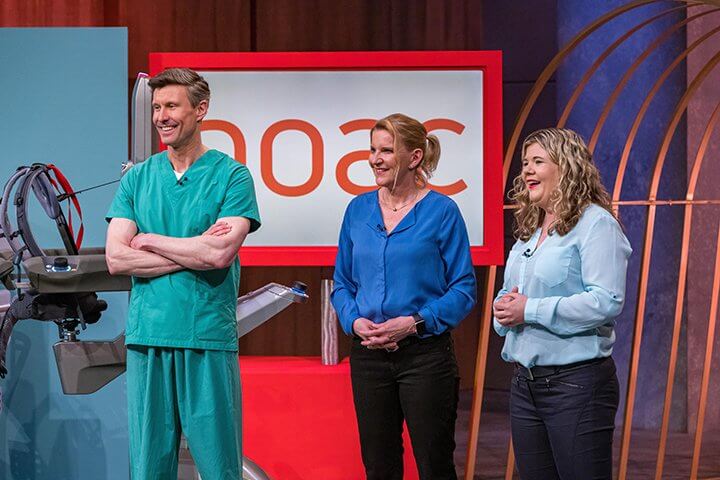Noac: How full can a cap table be? #DHDL
It's not just something you've heard many times on "Die Höhle der Löwen", but all other founders who have ever been looking for investors are probably familiar with the critical questions about the cap table. How many parties hold shares in the company, how many investors are there, how many founders? Investment talks can also fail if the structure is unfortunate. The start-up around the innovative surgical robotics "Noac" also had to realise that they are probably not so favourably positioned here.
Wednesday,
15.05.2024

All the lions were very enthusiastic about the product in general. The robotic support for surgeons, which is designed to prevent pain caused by hours of unfavourable posture during operations, was generally perceived as very innovative and extremely useful.
The startup around founders Claudia and Sabrina had already made a clever move here by bringing a doctor who was convinced by their development directly to the pitch and letting him demonstrate the device himself.
But even the most innovative and sensible invention cannot spare a founding team what every investor really has to check sooner or later: the profitability of the entire business model.
And in this case, a valuation of a whopping 20 million euros was already on the cards, as the lions were to fork out one million euros but only receive 5% of the company shares in return. This made Ralf Dümmel laugh a little ironically right from the start.
After all, as Janna Ensthaler in particular was to confirm later on, most investors – at least those of the kind of lions – expect a certain weight in the shareholder group with such a sum, which is not normally the case with 5%. After all, the lions repeatedly emphasise that they are investing more than just money and want to play an active role in the company’s progress. However, if only 5% is offered, most investors lose interest from the outset. However, the Noac developers either didn’t seem to care or they were so convinced of their product that they believed they could make up for this effect.
This can certainly happen and such effects have also been observed in the cave in rare cases, but a valuation justification and, above all, an economic perspective must of course still be presented.
However, with one device sold and a turnover of around 88,000 euros, this was not yet the case by any stretch of the imagination. And the valuation justification with the 3 million euros that had already been invested on the one hand and the market prospects on the other also seemed far too thin for the lions in this context.
The founding team used a classic calculation of the total potential: from 3-4 operating theatres and 11,000 addressable clinics, this already resulted in a sales potential of 1 billion euros. Although a certain risk deduction seems to have been made in the calculation, it is more than dangerous to include such calculations in the valuation justification, even if they are helpful in other areas. And so Dagmar Wöhrl also directly questioned whether the cost structure of the hospitals would support this.
After all, the sad reality is that the healthcare system in most countries is chronically underfunded, meaning that even the most sensible and helpful options cannot be utilised simply for cost reasons. Sales to hospitals are therefore considered one of the most difficult – alongside schools.
The greatest sales potential is therefore of no help if it cannot be converted into actual sales – even if this is based on unfair or not particularly sensible circumstances.
However, the valuation, which is therefore difficult to comprehend, went hand in hand with another circumstance that is unlikely to make it easy for the start-up to collect further investment: The €3 million that has flowed in so far comes from a total of 13 investors, and there are also 4 other people on the founding team in addition to the two founders appearing in the cave.
So there are apparently 17 parties on the cap table, which always gives potential new investors something to think about. What happens if urgent decisions have to be made among the shareholders and some of them can’t be reached? After all, the probability of this happening is much higher with 17 participants than with 5, and there are also concerns such as Janna Ensthaler’s about how much weight one’s comments carry in such a large group.
In this case, there was also the fact that the founders present were not really able to communicate their large team of six founders despite the arguments put forward by the experts. Another cardinal error in dealing with critical requirements: if a team consists of many founders, so that scepticism on the part of investors must be expected, it is simply not enough if only two out of six of the people in question appear. Of course, there are exceptions, for example if a team member only has very few shares because he or she provided a lot of support in the initial phase or is otherwise paid “normally”.
However, as Carsten Maschmeyer also notes, only 1/3 of the founders present are simply too few, and can offend investors in a similar way to a much too high valuation.
It was precisely these two factors that caused all the lions who were still interested to drop out. In retrospect, however, the founders do not seem particularly disappointed.
However, anyone who is interested in a positive outcome to investor talks should prepare well if it is already clear that there are critical points in the setup. Many investors can be “pooled” into a structurally small number, and even a promise of willingness to talk can often send a positive signal. Of course, the usefulness of the investors can also be argued, the previous successes they have helped to achieve or the added value beyond the money that can still be expected from them. In addition, well-established and efficient communication structures that have already proved their worth can counteract the fear that individuals are unreachable.
The “too full cap table” argument therefore does not have to be a statement that spells the end of negotiations if you take your counterpart’s concerns seriously and address the relevant issues early enough.
The lion’s far too high rating and the other unanswered questions would probably not have made the difference for the Noac, but of course we can only hope that it will soon find its way into many operating theatres.
Photo (above): TVNOW / Bernd-Michael Maurer

Ruth Cremer
Ruth Cremer is a mathematician and consultant as well as a university lecturer in the field of business models, key figures and financial planning. As a former investment manager, she knows what investors look for and also helps with pitch and document preparation in the investment or acquisition process. Since 2017, she is involved as an external consultant in the selection and preparation of the candidates in "Die Höhle der Löwen".
